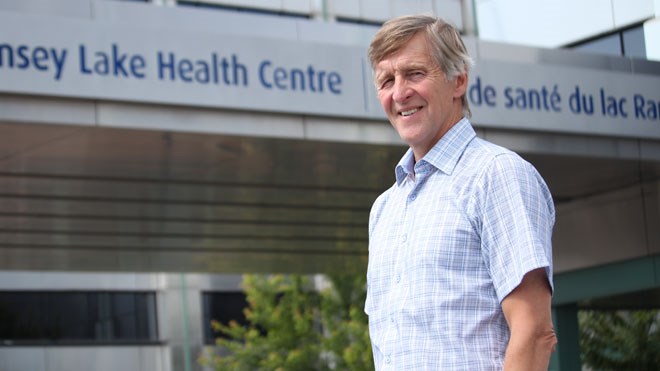Over the last decade, there has been a dramatic decline in many serious illnesses in Ontario, including lung cancer and cardiovascular disease, said Public Health Ontario's (PHO) chief science officer and senior scientist.
That decrease is based on the reduction of tobacco use and smoking over the past 20 years, said John McLaughlin, a leader in Canadian population health and cancer research. He was in Sudbury on Aug. 14, where he visited Health Sciences North and its research facility, HSNRI, on Walford Road.
“At the same time, across society, we've seen such a robust change in behaviours when it comes to smoking,” he said. “Fewer people are smoking now, and air quality in public places is much cleaner as a result, and it all leads to health benefits. However, there are subsets of the population where it's not always true. In places where the cost of tobacco is less, the use is higher, and it's these inequities that need to be addressed.”
That was one point McLaughlin made during his visit. The purpose of that visit? To create stronger links between PHO and the local communities, its researchers and academics.
“We've been able to obtain many different research grants for population-wide programs that have never been done in Canada, and I would very much like to partner with the research leaders here to allow that type of work to be done here as well,” he said.
PHO focuses more on preventing illnesses, which is why it's vital to work with the medical community to foster programs that can improve health and maintain early childhood development.
“Interestingly, much of the advancements made in society has caused us to sit more and be active less,” he said. “One of the programs our health promotion teams is working on is related to helping kids to be physically active and have access to high-quality foods, which helps balance calorie intakes and helps with long-term factors in a wide range of outcomes.”
McLaughlin, who helped build other research institutes in his time, said he's impressed with the Walford Road facility.
“It was a delightful beginning to my day,” he said of his tour. “I can appreciate the tremendous accomplishment of what they've done, and I give the architects credit for doing something pretty clever with an old school. It's a very functional space, so I commend the community for investing in the idea of such a research institute. It's exactly the kind of program that my group, and myself personally, would be delighted to continue to support and partner with, foster and help them succeed. I predict great things for HSNRI.”
Dr. Janet McElhaney, HSNRI's VP of research and scientific director, said a partnership with PHO represents a very important intersection in the new direction HSNRI has taken.
“We are moving into a population health focus, where we're looking at ... what people's needs are before they walk through our hospital doors,” said McElhaney.
“We want to lower the risk for multiple chronic conditions and cancers that we know we're at an increased risk for in Northern Ontario.”
HSNRI has received funding through the Canadian Institute of Health Research for Indigenous health initiatives to study healthy aging, she said.
There are three research projects she is particularly excited about.
The first will look at multiple chronic conditions that increase people's risk for disability in Indigenous communities. This is a community-based project, where the community will drive the development of the model of care that will best serve their community.
It will focus on people aged 45 years and older, with the understanding that risk happens at an earlier age for Indigenous peoples, McElhaney said.
The second project looks at the risk of multiple chronic conditions in older people going on to develop dementia, and how do health care providers support caregivers. It will focus on the strengths of Indigenous community to support their elders to age in place.
The third project will see the development of a digital storytelling platform.
“How Indigenous communities learn and develop is through storytelling, and we'll be able to capture that in some sort of digital medium that will support these communities in telling us how they've advanced health with these kinds of initiatives,” McElhaney said.
Building partnerships with organizations like PHO is about reducing risk at a population level, she said. “We don't want preventative approaches to start when someone walks through the doors of their physician's office or a hospital,” McElhaney said. “We want to start way before that to prevent the need for those health care services.
“We have to develop collaborative networks; that's the only way to survive in research. The days of the single scientist doing one project doesn't work any more. What we're really understanding now is the value of networking.
“Dr. McLaughlin has brought in a whole community of networks organized under Public Health Ontario, and how we can more successfully partner with that initiative is really what's going to bring this down to a local level. We've got lots of technology that gives us access to data, but partnerships between people are what drives these initiatives.”
